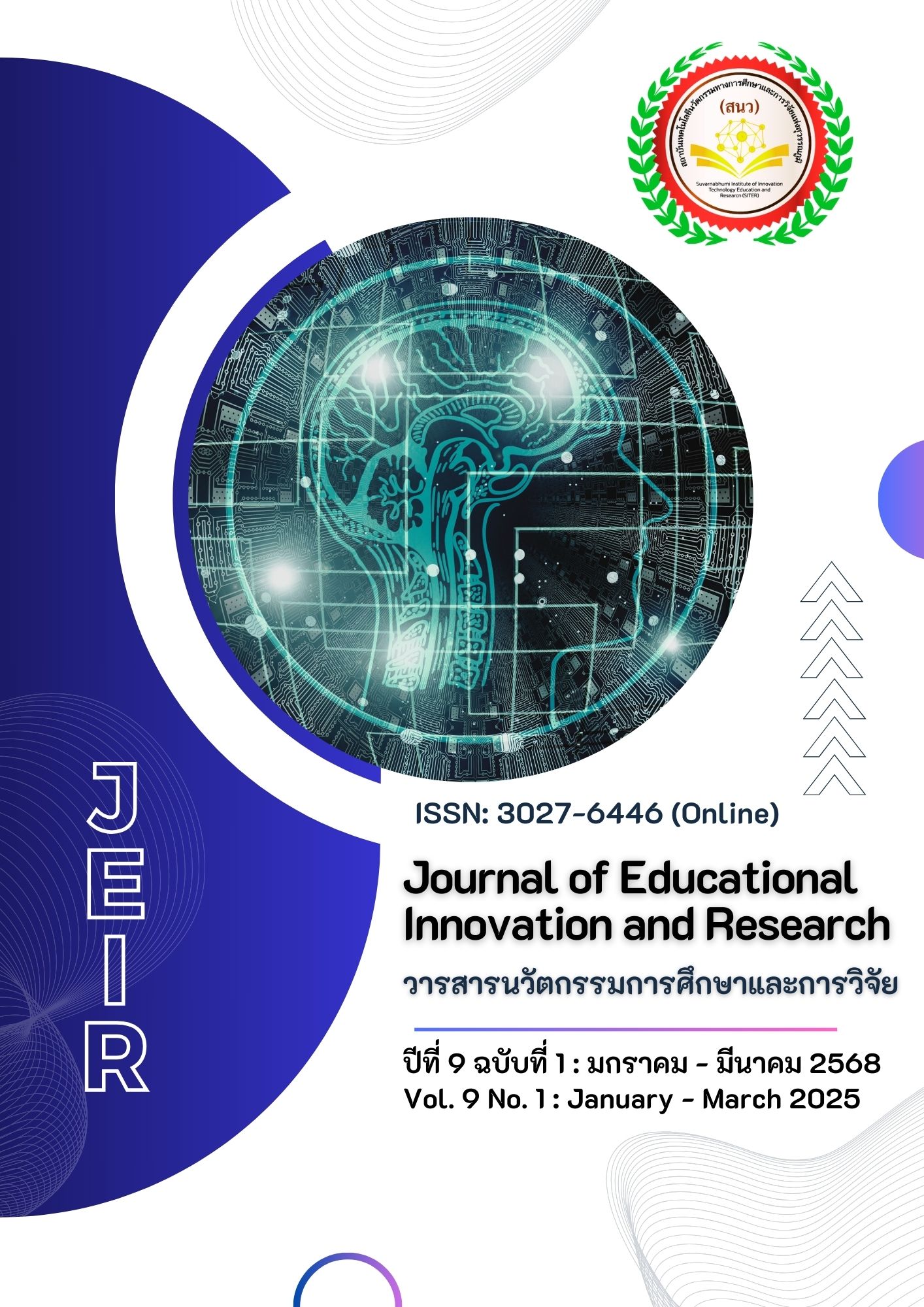การพัฒนาความสามารถในการแก้ปัญหาทางคณิตศาสตร์ ด้วยการจัด การเรียนรู้แบบร่วมมือด้วยรูปแบบ STAD ร่วมกับกระบวนการแก้ปัญหา DAPIC เรื่อง ความน่าจะเป็น สำหรับนักเรียนชั้นมัธยมศึกษาปีที่ 3
Main Article Content
บทคัดย่อ
บทความนี้มีวัตถุประสงค์ 1) เพื่อศึกษาแนวทางการจัดการเรียนรู้แบบร่วมมือด้วยรูปแบบ STAD ร่วมกับกระบวนการแก้ปัญหา DAPIC ที่พัฒนาความสามารถในการแก้ปัญหาทางคณิตศาสตร์ เรื่อง
ความน่าจะเป็น สำหรับนักเรียนชั้นมัธยมศึกษาปีที่ 3 และ 2) เพื่อพัฒนาความสามารถในการแก้ปัญหาทางคณิตศาสตร์ด้วยจัดการเรียนรู้แบบร่วมมือด้วยรูปแบบ STAD ร่วมกับกระบวนการแก้ปัญหา DAPIC เรื่อง ความน่าจะเป็น สำหรับนักเรียนชั้นมัธยมศึกษาปีที่ 3 รูปแบบการวิจัยนี้เป็นการวิจัยเชิงคุณภาพโดยมีกลุ่มตัวอย่าง คือ นักเรียนชั้นมัธยมศึกษาปีที่ 3 โรงเรียนเทศบาล 3 (ชาญวิทยา) จังหวัดเพชรบูรณ์ จำนวน 20 ซึ่งได้มาจากการสุ่มแบบกลุ่ม ใช้รูปการวิจัยเชิงปฏิบัติการจำนวน 3 วงจร เวลา 9 ชั่วโมง เครื่องมือที่ใช้ในการทำวิจัย คือ แผนการจัดการเรียนรู้ แบบสะท้อนผลการจัดการเรียนรู้ ใบกิจกรรม และแบบทดสอบวัดความสามารถในการแก้ปัญหา ทำการวิเคราะห์ข้อมูลเชิงเนื้อหาและตรวจสอบข้อมูลแบบสามเส้า
ผลการวิจัยพบว่า 1) แนวทางการจัดการเรียนรู้แบบร่วมมือด้วยรูปแบบ STAD ร่วมกับกระบวนการแก้ปัญหา DAPIC ที่พัฒนาความสามารถในการแก้ปัญหาทางคณิตศาสตร์ มีประเด็นที่ควรเน้น ได้แก่ การทบทวนความรู้เดิมเพื่อให้นักเรียนสามารถเชื่อมโยงความรู้เดิมไปสู่เนื้อหาใหม่ได้ การนำเสนอสถานการณ์ปัญหาควรเป็นสถานการณ์ที่เกี่ยวข้องกับชีวิตจริงของนักเรียน การแบ่งกลุ่มควรคละความสามารถหรือคละเพศของนักเรียน เพื่อให้นักเรียนสามารถทำงานร่วมกันได้ การเปิดโอกาสให้นักเรียนได้ร่วมกันแลกเปลี่ยนเรียนรู้ และการเสริมแรงทางบวกเพื่อส่งเสริมเจตคติที่ดีต่อการเรียนวิชาคณิตศาสตร์ 2) หลังการจัดการเรียนรู้แบบร่วมมือด้วยรูปแบบ STAD ร่วมกับกระบวนการแก้ปัญหา DAPIC ทำให้นักเรียนส่วนใหญ่มีความสามารถในการแก้ปัญหาทางคณิตศาสตร์อยู่ในระดับดี จำนวน 18 คน คิดเป็นร้อยละ 90
Article Details

This work is licensed under a Creative Commons Attribution-NonCommercial-NoDerivatives 4.0 International License.
References
Boonarkas, W. (2013). The Effects of The STAD Cooperative Learning Technique towards Learning Achievement and Critical Thinking Skills in Mathematics of Pratomsuksa 6 Students [Master’s Thesis, Rambhai Barni Rajabhat University].
Boonpichetwong, W. (2023). The Development Learning Actives on Constructionism theory Thorough social Network for Achievement and Life and Career Skills in the 21st Century of Mathayomsuksa 6 studrnt. Udon Thani Rajabhat University Journal of Guru Education, 5(2), 132-141.
Deelamai, J., Somchaipeng, T. & Kasemsukpipat, W. (2024). A study of Mathematical Critical Thinking Abilities on Linear Equation System in Two Variables of Grade 9Students with Learning Activities Using Mathematical Modelling. Journal of Educational Innovation and Research, 2(1), 51-67.
Duangthum, C. & Poonpaiboonpipat, W. (2022). The Development of Mathematical Literacy Through Online Learning Inplementation Based on Mathematizing Process in the Topic of Probability for Grade 11 Students. Journal of Roi Kaensarn Academi, 8(5), 146-164.
Ekthamasuth, C., Taweesuk, P. & Wadyim, W. (2016). Teaching Model to Enhance Creative Problem Solving. Journal of Boromarajonani College of Nursing, 32(3), 110-121.
Funfuengfu, V. (2019). The Success of Active Learning Management. Valaya Alongkorn Review, 9(1), 135-145.
Gagné, R. M. (1985). The conditions of learning (4th ed.). Rinehart & Winston.
Inta, K., Chaiworn, P. & Ratchawet, R. (2015). The Learning Activity Packages Creation with the Title “Amazing Rubber” by using STEM Education Curriculum and 21st Century Skills Development for Secondary Education Level.Journal of Faculty of Education Pibulsongkram Rajabhat University, 2(1), 132-141.
Kemmis, S. & McTaggart, R. (1988). The Action Research Planer (3rd ed). Victoria Deakin University.
Kennedy, L. M. (1984). Guiding Children’s Learning of Mathematics (4th ed). Wadsworth Publishing.
Makanong, A. (2016). Mathematical skills and processes Development for development. Chulalongkorn University Printing House.
Manesanguan, S. (2012). Mathematics teaching behavior 2 (2nd ed). Ramkhamhaeng University Press.
Ministry of Education. (2017). 2008 Basic Education Core Curriculum (Revised Edition 2017).
The Publishing of Shipping Organization and Parcel.
Office of the Education Council Secretariat. (2017). National Education Plan 2017 - 2036. Prik Wan Graphic.
Phetchabun Provincial Education Office (2022, September 27). Educational information in Phetchabun Province 2022. https://www.pnbpeo.go.th/web/list/data/5903dffdf25f9ec8bc42c20019dd7f7f .pdf
Polya, G. (1980). Problem Solving in School Mathematics. National Council of Teachers of Mathematics.
Slavin, R. E., (1990). Cooperative Learning: Theory, Research and Practice. Prentice - Hall.
Suwannapaeng, P. & Kongson, R. (2022). The development of mathematics problem–solving skills and critical thinking skills by using the DAPIC problem-solving process with KWDL techniques for Grade ninth students. Journal of Educational Studies, 16(2), 104-119.
Thorod, N., Angganapattarakajorn, A. & Jenjit, A. (2020). The Effects of Problem-Based Learning Management with SSCS Problem Solving Model on Mathematical Problem Solving and Written Communication Abilities on Mathayomsuksa 6 Students. Social Sciences Research and Academic Journal, 15(2), 87-100.
Treesadand, P. & Art-in, T. (2023). The Development of Mathematics Problem Solving ability and Teamwork and Collaboration Competency using the Activity Based Learning Modelwith Flipped Classroom for grade 11 students. Journal of Roi Kaensarn Academi, 8(5), 146-164.
Yeneng, S. (2018). Students Responsibility Behavior Modification by Positive ReinforcementContingency and Suggestion Technique. Journal of Vocational Education in Agriculture, 2(1), 11-25.

